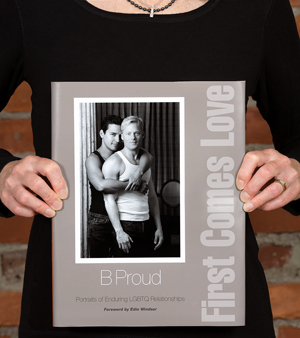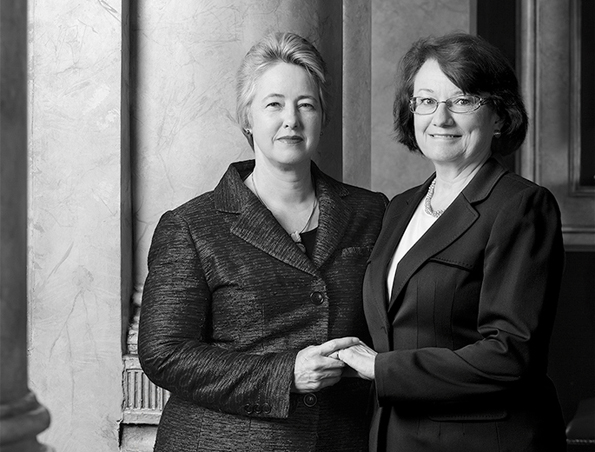Q&A: ‘First Comes Love’ creator prepares for release of beautiful new book
September 17, 2014
 Next week, on September 26, another step of one photographer's mission of compiling a beautiful collection of portraits of loving, committed LGBTQ couples will come to fruition when Barbara Proud's First Comes Love book is released.
Next week, on September 26, another step of one photographer's mission of compiling a beautiful collection of portraits of loving, committed LGBTQ couples will come to fruition when Barbara Proud's First Comes Love book is released.
The book is one element of the First Comes Love collection, a traveling exhibition of portraits, stories, and videos that capture LGBTQ couples together for decades. The beautiful black-and-white photographs include a wide range of couples - from couples who have prominently and famously fought for the freedom to marry, like Houston Mayor Annise Parker and her wife Kathy Hubbard - to friends of Proud to everyday couples leading their lives as examples of why marriage matters to all families. It is a celebration of love, an example of 65 couples who have committed their lives to each other, and a reminder that this national discussion and nationwide campaign intimately concerns real people and real families.
Freedom to Marry's founder and president Evan Wolfson praised Proud's work in a testimonial on the back cover: "First Comes Love has it right," he said. "It’s the faces and stories of real people that open hearts and minds and pave the way to legal and social change.”
The book also features a forward by Edie Windsor, the plaintiff whose story and legal case helped bring down the core of the so-called Defense of Marriage Act in June 2013.
To learn more about First Comes Love, Freedom to Marry spoke with B. Proud about the book release, her methods, her motivations, and what she hopes to accomplish with this stunning collection of portraits. You can learn more and pre-order the book HERE.
 How does it feel to release the book, after photographing so many couples?
How does it feel to release the book, after photographing so many couples?
Indescribably delicious! It feels amazing to hold this book in my hands. I can't wait to let it out into the world. Virtually all of the wonderful couples in the First Comes Love Project thanked me for doing this work. They were eager to tell their stories and I am proud and honored to be their voice.
 As the national momentum continues to grow for the freedom to marry, with nearly 40 court rulings in favor of marriage for all and several seeking Supreme Court review, why is your book - and the photos of so many loving couples - a powerful reflection of our nation's journey?
As the national momentum continues to grow for the freedom to marry, with nearly 40 court rulings in favor of marriage for all and several seeking Supreme Court review, why is your book - and the photos of so many loving couples - a powerful reflection of our nation's journey?
Little did I know when I began the project that so much would happen – particularly in 2013. There is a tremendous momentum now for marriage equality, and many people foresee a time when the entire country will be even more accepting of the LGBTQ community. As I've said many times, however, changing laws does not necessarily change minds and attitudes. It's important that people know and understand us so that they accept us in spirit and not just because a law demands it. This is the only way provide a safe place for our younger generations to grow and flourish. I'm hoping that my book and the accompanying exhibition will help to accomplish that.
|
"Changing laws does not necessarily change minds and attitudes. It's important that people know and understand us so that they accept us in spirit and not just because a law demands it."
|
In light of the events that have taken place in these recent years, I think that my book stands as more than just a collection of photographs and text. It is a historical document. I am fortunate to call people such as the late Barbara Gittings and her partner Kay Tobin Lahusen, my friends. People like Barbara and Kay and Lilli Vincenz and Nancy Davis were at the forefront of the gay movement in the late 60s and early 70s. I am honored to have them included in this book. Now and in the future, people will be able to read these stories and get a sense of the real lives and struggles of a community fighting for its freedom. My book is not about the big events that we see in the media. It's about the day-to-day lives of some really incredible people. Sometimes even our staunchest allies don't realize the discrimination that we face. I hope that my book will shed some light on that.
In terms of the timing of the book, how lucky am I to have met and been able to include Bishop V. Gene Robinson and Mark (despite the fact that they have unfortunately recently separated), Kris Perry and Sandy Stier, Paul Katami and Jeff Zarrillo, Beth Stephens and Annie Sprinkle, Thomas Allen Harris and Don Perry, Sinjoyla Townsend and Angelisa Young (the first couple married in the nation's capitol), Lisa B. Goodman and Drew Fennell (the first civil union in the state of Delaware), Mayor Annise Parker of Houston and Kathy Hubbard, Ruthie Berman and Connie Kurtz, the one and only Edie Windsor, and so many more.
I think that I have compiled a wonderfully diverse and significant collection of couples at an incredibly poignant moment in our nation's history.

What motivated you to begin First Comes Love?
It really was a series of things, starting with my 20th anniversary with my partner. That event made us the longest-surviving couple in our families, and for years, we've been the go-to couple for our family.
Shortly after our anniversary was the 2008 election, where President Obama was elected, which was great, but then in the same election, Proposition 8 passed in California - plus a few other ballot measures in Arizona and Arkansas. That really upset me - and my sadness over the election paired with my happiness at my anniversary served as motivation for First Comes Love.
I had just finished a fine art series, and I needed a new project, so I decided to make one that celebrated our relationships and was socially conscious and worked to change some minds on LGBTQ relationships. I decided to celebrate the couples in our community who have been together for a very, very long time.
 What have you learned from your work with First Comes Love?
What have you learned from your work with First Comes Love?
Aside from learning more about the best way to showcase the diversity and strength of our community, I also learned some technical skills - First Comes Love was my first time filming video. So, in addition to the photographs, I was able to interview the couples on video and have footage for video stories to supplement the portraits.
What do you most hope audiences take away from First Comes Love?
I know that in many ways, I'm preaching to the choir with First Comes Love - but I think the project does a good job at celebrating all of these couples. I deliberately decided to make the portraits black and white because I wanted to strop away all of the rainbow connotations people have about the LGBT community and challenge the typical view of what's portrayed in the media, which is usually some sort of protest or parade. I wanted to strip these portraits down to the essence of who these people are: Real people, living everyday lives, going through the same things that many other people go through.
I'd eventually like the exhibit to be shown in public places where people unfamiliar with the LGBTQ community can learn more about these people, their lives, and their love.
Learn more about First Comes Love HERE, and preorder HERE.
